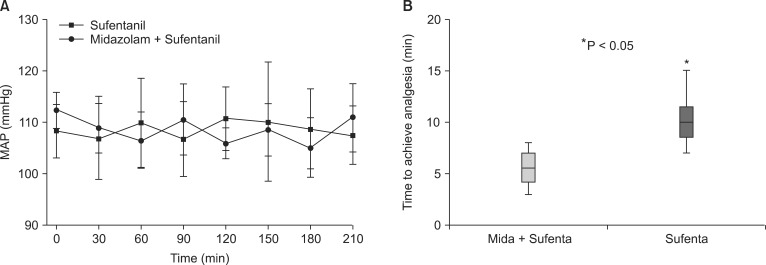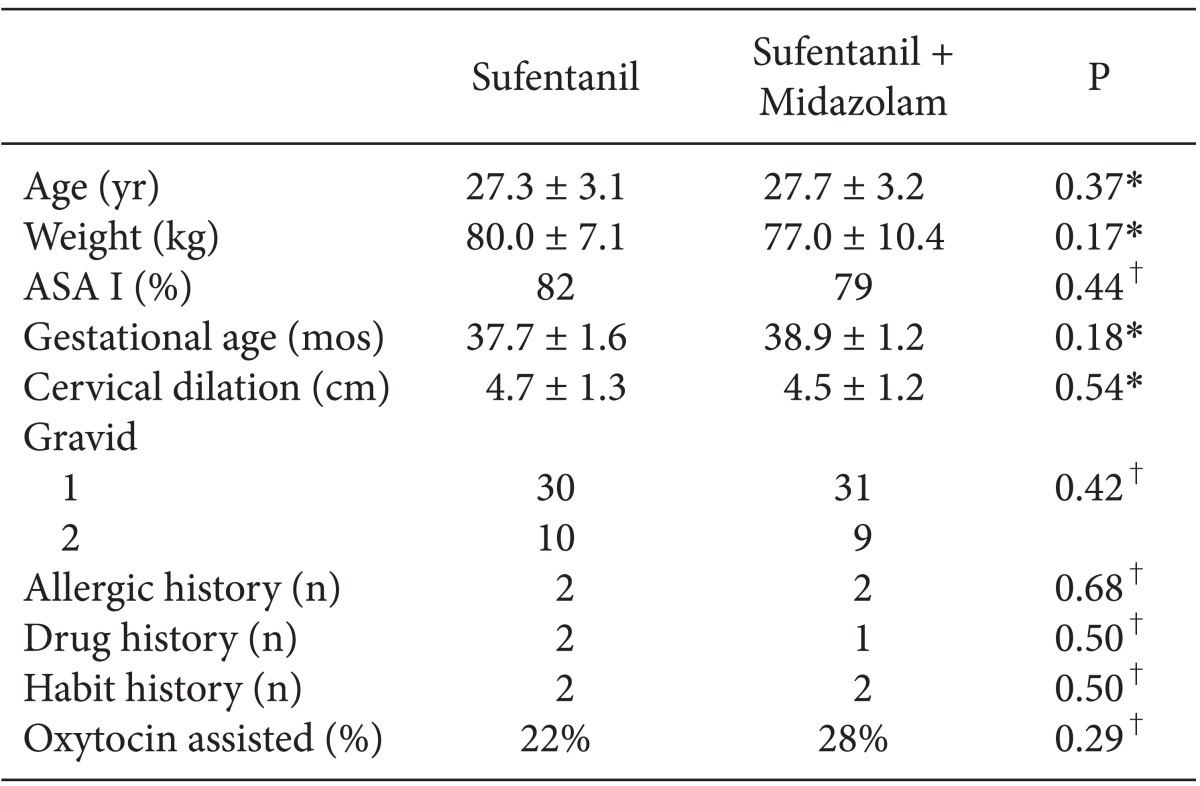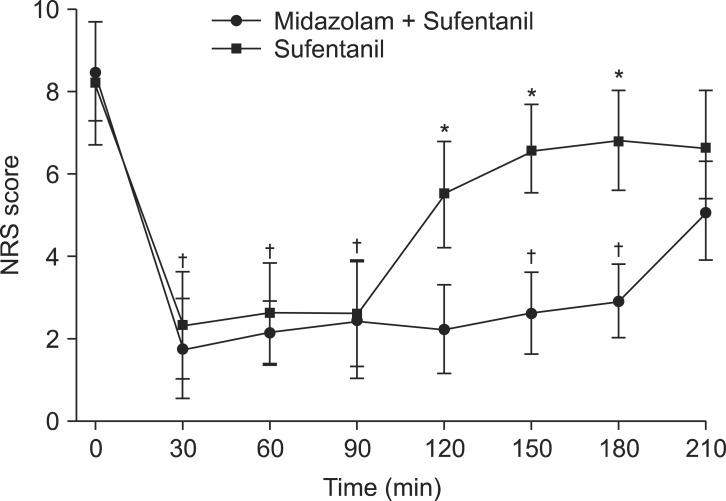1. Minty RG, Kelly L, Minty A, Hammett DC. Single-dose intrathecal analgesia to control labor pain: is it a useful alternative to epidural analgesia. Can Fam Physician. 2007; 53:437–442. PMID:
17872679.
2. Cambic CR, Wong CA. Labour analgesia and obstetric outcomes. Br J Anaesth. 2010; 105(Suppl 1):i50–i60. PMID:
21148655.

3. Lee BB, Ngan Kee WD, Hung VY, Wong EL. Combined spinal-epidural analgesia in labour: comparison of two doses of intrathecal bupivacaine with fentanyl. Br J Anaesth. 1999; 83:868–871. PMID:
10700784.

4. Vasudevan A, Snowman CE, Sundar S, Sarge TW, Hess PE. Intrathecal morphine reduces breakthrough pain during labour epidural analgesia. Br J Anaesth. 2007; 98:241–245. PMID:
17210732.

5. Yaksh TL, Allen JW. The use of intrathecal midazolam in humans: a case study of process. Anesth Analg. 2004; 98:1536–1545. PMID:
15155302.

6. Kim MH, Lee YM. Intrathecal midazolam increases the analgesic effects of spinal blockade with bupivacaine in parturients undergoing haemorrhoidectomy. Br J Anaesth. 2001; 86:77–79. PMID:
11575414.
7. Yaksh TL, Allen JW. Preclinical insights into the implementation of intrathecal midazolam in humans: a cautionary tale. Anesth Analg. 2004; 98:1509–1511. PMID:
15155298.
8. Prakash S, Joshi N, Gogia AR, Prakash S, Singh R. Analgesic efficacy of two doses of intrathecal midazolam with bupivacaine in parturients undergoing cesarean delivery. Reg Anesth Pain Med. 2006; 31:221–226. PMID:
16701187.
9. Tucker AP, Lai C, Nadeson R, Goodchild CS. Intrathecal midazolam I: a cohort study investigating safety. Anesth Analg. 2004; 98:1512–1520. PMID:
15155299.

10. Tucker AP, Mezzatesta J, Nadeson R, Goodchild CS. Intrathecal midazolam II: combination with intrathecal fentanyl for labor pain. Anesth Analg. 2004; 98:1521–1527. PMID:
15155300.

11. Melzack R, Kinch R, Dobkin P, Lebrun M, Taenzer P. Severity of labour pain: influence of physical as well as psychologic variables. Can Med Assoc J. 1984; 130:579–584. PMID:
6697268.
12. Kim MH, Lee YM. Intrathecal midazolam increases the analgesic effects of spinal blockade with bupivacaine in parturients undergoing haemorrhoidectomy. Br J Anaesth. 2001; 86:77–79. PMID:
11575414.
13. Minty RG, Kelly L, Minty A, Hammett DC. Single-dose intrathecal analgesia to control labour pain: is it a useful alternative to epidural analgesia. Can Fam Physician. 2007; 53:437–442. PMID:
17872679.
14. Wu YW, Shiau JM, Hong CC, Hung CP, Lu HF, Tseng CC. Intrathecal midazolam combined with low-dose bupivacaine improves postoperative recovery in diabetic mellitus parturients undergoing foot debridement. Acta Anaesthesiol Taiwan. 2005; 43:129–134. PMID:
16235460.
15. Agrawal N, Usmani A, Sehgal R, Kumar R, Bhadoria P. Effect of intrathecal midazolam bupivacaine combination on post operative analgesia. Indian J Anesthesia. 2005; 49:37–39.
16. Kohno T, Wakai A, Ataka T, Ikoma M, Yamakura T, Baba H. Actions of midazolam on excitatory transmission in dorsal horn neurons of adult rat spinal cord. Anesthesiology. 2006; 104:338–343. PMID:
16436854.

17. Lim J, Lim G, Sung B, Wang S, Mao J. Intrathecal midazolam regulates spinal AMPA receptor expression and function after nerve injury in rats. Brain Res. 2006; 1123:80–88. PMID:
17049496.

18. Cox RF, Collins MA. The effects of benzodiazepines on human opioid receptor binding and function. Anesth Analg. 2001; 93:354–358. PMID:
11473860.

19. Goodchild GS, Guo Z, Musgreave A, Gent JP. Antinociception by intrathecal midazolam involves endogenous neurotransmitters acting at spinal cord delta opioid receptors. Br J Anaesth. 1996; 77:758–763. PMID:
9014630.

20. Crawford ME, Jensen FM, Toftdahl DB, Madsen JB. Direct spinal effect of intrathecal and extradural midazolam on visceral noxious stimulation in rabbits. Br J Anaesth. 1993; 70:642–646. PMID:
8329258.

21. Valentine JM, Lyons G, Bellamy MC. The effect of intrathecal midazolam on post-operative pain. Eur J Anaesthesiol. 1996; 13:589–593. PMID:
8958490.

22. Frölich MA, Burchfield DJ, Euliano TY, Caton D. A single dose of fentanyl and midazolam prior to Cesarean section has no adverse neonatal effects. Can J Anaesth. 2006; 53:79–85. PMID:
16371613.
23. Malinovsky JM, Cozian A, Lepage JY, Mussini JM, Pinaud M, Souron R. Ketamine and midazolam neurotoxicity in the rabbit. Anesthesiology. 1991; 75:91–97. PMID:
2064066.

24. Safari F, Dabbagh A, Sharifnia M. The effect of adjuvant midazolam compared with fentanyl on the duration of spinal anesthesia with 0.5% bupivacaine in opium abusers. Korean J Anesthesiol. 2012; 63:521–526. PMID:
23277813.

25. Canavero S, Bonicalzi V, Clemente M. No neurotoxicity from long-term (>5 years) intrathecal infusion of midazolam in humans. J Pain Symptom Manage. 2006; 32:1–3. PMID:
16824978.
26. Erdine S, Yücel A, Ozyalçin S, Ozyuvaci E, Talu GK, Ahiskali B, et al. Neurotoxicity of midazolam in the rabbit. Pain. 1999; 80:419–423. PMID:
10204757.

27. Malinovsky JM, Cozian A, Lepage JY, Mussini JM, Pinaud M, Souron R. Ketamine and midazolam neurotoxicity in the rabbit. Anesthesiology. 1991; 75:91–97. PMID:
2064066.






 PDF
PDF Citation
Citation Print
Print





 XML Download
XML Download